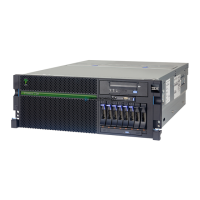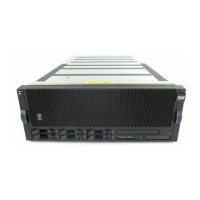138 IBM Power 720 and 740 Technical Overview and Introduction
At the time of writing, virtual SCSI supports Fibre Channel, parallel SCSI, iSCSI, SAS, SCSI
RAID devices, and optical devices, including DVD-RAM and DVD-ROM. Other protocols such
as SSA and tape devices are not supported.
For more information about specific storage devices that are supported for Virtual I/O Server,
see the following web page:
http://www14.software.ibm.com/webapp/set2/sas/f/vios/documentation/datasheet.html
N_Port ID Virtualization
N_Port ID Virtualization (NPIV) is a technology that allows multiple logical partitions to access
independent physical storage through the same physical Fibre Channel adapter. This adapter
is attached to a Virtual I/O Server partition that acts only as a pass-through, managing the
data transfer through the POWER Hypervisor.
Each partition that uses NPIV is identified by a pair of unique worldwide port names, enabling
you to connect each partition to independent physical storage on a SAN. Unlike virtual SCSI,
only the client partitions see the disk.
For additional information and requirements for NPIV, see the following resources:
PowerVM Migration from Physical to Virtual Storage, SG24-7825
IBM PowerVM Virtualization Managing and Monitoring, SG24-7590
Virtual I/O Server functions
The Virtual I/O Server has several features, including monitoring solutions:
Support for Live Partition Mobility starting on POWER6 processor-based systems with the
PowerVM Enterprise Edition. For more information about Live Partition Mobility, see 3.4.5,
“PowerVM Live Partition Mobility” on page 139.
Support for virtual SCSI devices backed by a file, which are then accessed as standard
SCSI-compliant LUNs.
Support for virtual Fibre Channel devices that are used with the NPIV feature.
Virtual I/O Server Expansion Pack with additional security functions such as Kerberos
(Network Authentication Service for users and client and server applications), Simple
Network Management Protocol (SNMP) v3, and Lightweight Directory Access Protocol
(LDAP) client functionality.
System Planning Tool (SPT) and Workload Estimator, which are designed to ease the
deployment of a virtualized infrastructure. For more information about the System
Planning Tool, see 3.5, “System Planning Tool” on page 149.
IBM Systems Director agent and several preinstalled IBM Tivoli® agents, such as the
following examples:
– Tivoli Identity Manager, to allow easy integration into an existing Tivoli Systems
Management infrastructure
– Tivoli Application Dependency Discovery Manager (ADDM), which creates and
automatically maintains application infrastructure maps including dependencies,
change-histories, and deep configuration values
vSCSI enterprise reliability, availability, serviceability (eRAS)
